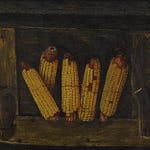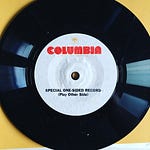Were old toys always creepy? This is a question I’ve asked myself ever since I saw an early Mickey Mouse doll in an antique store as a kid. You’ve probably seen photos of these (I can’t get the rights to publish one here, so click that link). Mickey is more rat than mouse. Instead of the sweet roundness from the cartoon, the doll’s face is pointed—its snout extends in an upward curve. The whiskers are either drawn on or they’re made of yarn that doesn’t seem quite long enough. The stitches down the front of the face give the doll shape, but make it seem like it’s recovering from post-surgery swelling.
It doesn’t help that seeing one in person today means looking at it under decades of dirt, discoloration, and smudged fingerprints. The dolls are more like anthropological specimens than toys. That corner of the antique store where I first saw the cursed Mickey also had lifelike dolls from the ‘30s, their paint chipped and cracked. If you see an old toy in a photo, it’s usually a blurry home snapshot in sepia or black and white with unexpected shadows and film grain, held by a stranger or by a younger version of a loved one who is so unrecognizable in youth that they may as well be a stranger.
I wonder if this is uncharitable. Manufacturing technology wasn’t as advanced then. And my view is shaped by growing up in the ‘90s, a time of aggressive cuteness in kid’s entertainment. We’d progressed past the off-putting bulbousness of Cabbage Patch Kids into a general soft plushiness of big eyes and friendly faces. Toys for boys sometimes had “attitude,” conveyed through an arched eyebrow, a toothy sneer, or physical spikiness. But they were still abundantly cute. Sonic the Hedgehog embodies this. He’s fierce but lovable.
This is a surface-level assessment. Literally. Changes to the appearance of toys are the result of a change in the purpose of toys. Humans have played with dolls for most of our history. In the U.S., the industrializing, urbanizing nation changed how we make dolls and how we think about childhood. “By the end of the 19th century, many parents no longer saw their children as unfinished adults, but rather regarded childhood as a time of innocence that ought to be protected,” Linda Rodriguez McRobbie wrote in a history of creepy dolls for Smithsonian. “In turn, dolls’ faces took on a more cherubic, angelic look.”1
The march of cuteness continued as the protected period of youth expanded. This may not have been any conscious decision on the part of toymakers. The things we see as cute and the things we consider innocent are linked in our heads. “From the bud in springtime to the human infant to the clumsy kitten…everything is born cute,” the artist James Kochalka writes in The Cute Manifesto.2 The oversized eyes of cartoon characters mimic the shape of children’s faces. When toys become less lifelike, it’s usually the result of exaggerating features like this, or removing detail. And the less detail on a face, the more we can project ourselves onto it.3
Projection is key. Kochalka sees cuteness as not only the sign of youth, but the antidote to the ugliness of the adult world. “Cuteness is pure,” he writes. “Its unadulterated innocence shines like a beacon through the darkness of this world, untouched by evil or greed…Cuteness is simply a pure and rarefied form of beauty. Nothing is more beautiful than the cute because the cute is untouched by any foul thought or deed.”
So toys got cuter. This progress makes the toys of our own youth look off when viewed in a modern light. Whenever I visit family, I spend as much time as I can playing with my nieces and nephew. If we’re at my childhood home, I’ll go to my old bedroom and dust off a few toys to add to the fun. Looking through a box of Teenage Mutant Ninja Turtles figures with Linda and our young relatives this summer, I was surprised at how often I presented a figure and was met with “ew,” “I don’t like that,” or “what’s wrong with him?”

Then I got it. These action figures are humanoid animals made of plastic that’s textured to mimic the salmonella slick skin of amphibians, the warts of toads, or the matted fur of sewer rats. They have the rude attitude of old boy’s toys, tempered for a six-year-old’s palette. It’s the palette of a six-year-old in the ‘90s, when these toys were slicker and cooler than anything that had come before. But by today’s standards, they’re too strange to be a kid’s toy. To a child in 2022, these figures are like an old Mickey Mouse doll is to a Millennial.
After the lukewarm reception from relatives, I put a couple Turtles in my bag to take home. I still have fond memories of these toys. And even though I understand how a child today might look at them, I can’t stop seeing them the way an adult in the ‘90s might have. It’s a mirror image of the child’s view. They’re not grotesque, just unrealistic and bizarre. They’re too strange to serve any practical purpose, but are clearly meant to be a little cute—they’re designed for a kid to play with.
Thinking about it further, the concept of “Teenage Mutant Ninja Turtles” is mind-boggling. The words don’t fit together. They may have started as an adult-oriented spoof of the Very Serious Superhero comics of the ‘80s, but the path the Turtles took after they became children’s entertainment is hard to understand if you’re far from the middle of the phenomenon. Imagine you were born a century ago. You came of age in the Great Depression. You served in the military or the war effort at home during World War II. You worked to earn a living in the economic prosperity of the 1950s. You raised your children through the societal upheaval of the ‘60s. When it was Morning in America, you retired with a pension and spent time with your grandkids. Then one day, just before Christmas, you found yourself in a KB Toys trying to decide whether to buy those grandkids something called Krang’s Android Body or a playset of the Technodrome, a gray ball with tank treads on the bottom and an eyeball on top. How does this seem real?
But you buy it, because even if it doesn’t make sense to you, it’s meant for someone for whom the real world isn’t yet a concern.
To some degree, popular culture should always be a little baffling and a little challenging. If you perfectly understand everything around you, you’re either omnipotent or sheltered. At the same time, that bubble of understanding and innocence seems awfully comfortable after we’ve experienced life outside of it.
To an adult now, computer-animated cartoons and toys from modern manufacturing plants might look too slick or overly engineered. Paw Patrol can seem saccharine in its smoothness. But as adults, we see the seams. We know there’s an ugliness outside of the bubble. We might want to puncture it as an early warning—life won’t always be like this, kid. But we don’t. Instead, we try to get back into the bubble—to extend it further into our lifespans. We obsess over the media of our youth and we let the media of adulthood become smoother, slicker, cuter in a grown-up way, until images of real humans are processed to look like computer renderings. It’s how we hold on to youth.
But at what point does prolonged youth turn into arrested development?
Looking through my old toys, I found one that I didn’t need to explain to a younger generation. It was a Buzz Lightyear figure I got when I was ten. At the time I got it, Toy Story had just arrived in theaters. At the time I found it, a new Buzz Lightyear movie was on the way. Unlike the Turtles, not much had changed with Buzz. He seemed just as new in 2022 as he did in 1995. I wondered—would my ten-year-old-self have been as familiar and comfortable with toys from 1968, or would I have found them as scary as a Mickey doll or a Leonardo action figure? Would I have recognized the world such an old toy came from?
“There is much suffering in life, but we do not exist merely to suffer. We exist to feel joy and to experience beauty,” Kochalka writes. Sometimes beauty is unfamiliar. And it’s comfortable to experience beauty through media built to be frictionless. But there is friction in life. There is ugliness and there is suffering and we can’t hide from it. The more we try to hide as adults, the more we surrender. We let the ugliness overtake everything outside of our hiding places. This is not embracing cuteness, as Kochalka describes it. We don’t “live in a fantasy world where we pretend that suffering does not occur. Rather, we fight for beauty and purity and we fight to make this world a more joyful place.”
To win the fight, you have to move forward. You have to make something new, and build a future that makes today seem old-fashioned.
These dolls were also lifelike, McRobbie writes, to encourage girls to practice mothering, making clothes, and other acts that reinforced the gender roles of the time.
There’s a theory that this is tied to our evolution. Since our survival as a species depends on our willingness to care for newborns, it makes sense that we would feel compelled to protect and preserve the things we find cute.
This idea comes from the comics theorist Scott McCloud’s book Understanding Comics. Surely the success of Peanuts is due, in part, to the fact that the star of the strip, Charlie Brown, is its least physically distinctive character. Even if you don’t like comic books, you should read McCloud’s book. It’s ostensibly about comics, but it’s really about how to effectively tell stories.
















Share this post